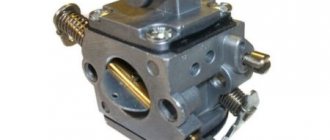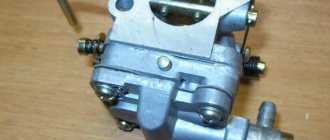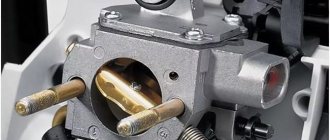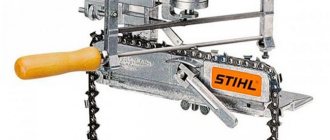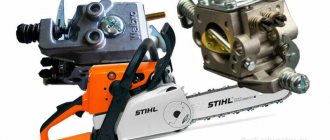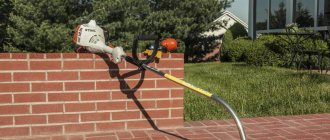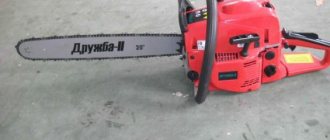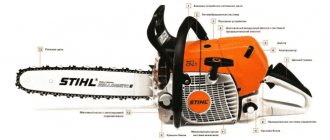When should it be adjusted?
First, you need to decide why you might need to adjust and repair the Stihl ms 180 carburetor. So, this needs to be done in the following cases:
- If the chainsaw does not hold idle speed;
- repairs may be required if the saw does not start;
- there is a loss of power;
- increased fuel consumption;
- the chainsaw does not develop maximum speed;
- stalls when revving up.
This list can be continued for a long time, but we have identified the main reasons. Before you start making adjustments, you need to know what main parts the carburetor on the Shtil MC 180 chainsaw consists of, and who makes it.
What carburetor is installed on the Shtil 180 chainsaw
Carburetor mounted on a Shtil 180 chainsaw
According to the site prokarbyrator.ru, the Shtil 180 chainsaw is equipped with a Japanese membrane-type carburetor from Zama. And although they are assembled in China, Zama is owned by Stihl.
There are Chinese analogues on the market that are noticeably cheaper than the original ones. Lower price, lower quality. Although the carburetor body bears the “Made in China” stamp, the company’s quality control guarantees high reliability and offers an additional guarantee for its products.
The original carburetors have the company logo on the body.
How to adjust it yourself, the nuances of setting
The carburetor of the Shtil 180 chainsaw, indiscriminately, can only be adjusted by the number of revolutions at idle. It is impossible to increase or decrease the fuel supply in various modes using special screws. The manufacturer limits access to adjustments and does not install these screws. How to adjust the carburetor to the correct idle speed is described in great detail in the manufacturer's instructions.
If certain malfunctions occur, and if you have experience, you can increase or decrease the fuel supply by increasing the gap when opening the needle valve.
To increase the flow, the rocker arm of the needle valve in the distribution chamber must be bent up, and to decrease, down. This regulates the stroke of the needle and, accordingly, the throughput of the valve.
You should not carry out the adjustment yourself, because this must be done very precisely and if there is an error, it is almost impossible to return the original position of the rocker arm.
Advice from professionals
Before adjusting the carburetor of the Shtil chainsaw, you need to inspect the spark plugs. Based on their condition and color, you can determine the need for surgery. If they are black, this indicates over-enrichment. With a brick gray color, you can be sure that everything is normal. If there is a white coating on the spark plug electrodes, the mixture is lean.
It is the top screw that plays the main role in adjusting the carburetor. It is located next to the muffler. If you follow the factory settings, which can be found on the housing cover, it should be unscrewed one turn. Then it is corrected. By unscrewing the screw, you make the working mixture richer, and more gasoline enters it. If the screw is screwed in, the working mixture will combine, and less gasoline will enter the fuel mixture.
Malfunctions and repairs
After we have examined the design of the carburetor, it is not difficult to determine the reason why fuel enters the combustion chamber in a larger volume. This happens due to wear of the gasket between the compensator cover and the carburetor body. How might this make an impact, you ask?
The answer is simple: as the gasket contracts, it releases the diaphragm on top of it a fraction of a millimeter down. This, in turn, will put more pressure on the needle valve rocker arm, it will open more than it should and fuel will flow in excess (it will begin to overflow).
Another reason is stretching of the diaphragm itself, this occurs as a result of natural wear and tear. It is impossible to prevent this process, but you can solve the problem by periodically changing all gaskets, carburetor diaphragms, and fuel pumps. There is a repair kit for this.
When cleaning a chainsaw with compressed air, never blow into the fuel pipe, as this can stretch the diaphragm.
Sticking injector valve - a common breakdown and how to avoid it?
A common cause of carburetor failure on a Stihl chainsaw is a stuck valve in the nozzle. The reason for sticking is a violation of the storage of the chainsaw, or rather the Shtil 180 manufacturer’s instructions for proper preparation for storage.
As follows from the instructions, before long-term storage, it is necessary to drain the fuel from the tank, then start the saw and burn off the gasoline from the carburetor. Failure to comply with this elementary rule entails the following consequences. The forsknui valve, being in direct contact with the fuel, sticks to the body, because the gasoline gradually evaporates and only sticky oil remains. You cannot replace the injector, since they are not in the repair kit; you can only try to knock it out and wash it, which is not always possible to do without damaging the injector.
Checking that the carburetor is properly cleaned
Detailed instructions on how to clean a chainsaw carburetor show that this procedure does not present any difficulties.
However, it is important to assess the condition of the device, and only then make a decision about the possibility of cleaning. The carburetor channels are very small, so during oxidation serious difficulties arise in cleaning them
In this case, you will only need to purchase a new carburetor.
This is interesting! It is necessary to understand that not all types of carburetors can be cleaned. This is especially true for branded chainsaws and trimmers, where it is simply impossible to reach the channels.
To make sure that the procedure was done correctly, you should put the carburetor on the chainsaw and do a test run. If necessary, make adjustments using a tachometer. At the final stage, it must be said that by regularly performing such actions, you can extend the life of not only the carburetor, but also the engine of the tool tenfold.
Design and principle of operation
So, the carburetor was developed and manufactured by a subsidiary of Stihl, called Zama. Original carburetors have the company logo on their body, guaranteeing product quality.
Appearance of the Zama carburetor
Fuel pump
A fuel pump is installed directly in the carburetor body, which operates under the influence of an air pulse from the chainsaw crankcase, transmitted through special channels. The pump has a diaphragm installed, which is responsible for pumping fuel under the influence of an impulse. A gasket is installed between the diaphragm and the housing, which is responsible for the tightness of the fuel pump.
Distribution chamber
In the distribution chamber, as in the fuel pump, there is also a membrane that opens and regulates the fuel supply by pressing a special rocker arm, which lifts its needle valve.
The chamber cover is the compensator body, which is attached to the carburetor using four screws; a gasket is installed between the body and the cover, which increases the height of the chamber and is responsible for sealing.
Nozzle
The fuel supply nozzle is mounted in the carburetor body in such a way that it is a connecting link between the distribution chamber and the cavity in which the throttle valve is installed. At the same time as the fuel, air is supplied to the injector and an air mixture is formed. The injector has a check valve that blocks the flow of air in the reverse order, that is, from the throttle chamber to the distribution chamber.
Throttle valve
The throttle valve is installed in the carburetor body and is responsible for increasing the flow of the fuel mixture directly into the engine cylinder. At the moment you press the gas, the throttle valve opens slightly, thereby increasing the throughput of the channel and fuel from the carburetor cavity rushes into the cylinder in a larger volume.
Combustion of a larger volume of fuel increases the amount of energy generated, which affects the power and speed of processes. The damper is installed on a shaft passing through the entire carburetor body. At the shaft exit from the housing, there is a fastening for the throttle cable, and next to it there is a cone-shaped adjusting screw responsible for adjusting the idle speed. By tightening the screw, you can slightly adjust the position of the shaft and the damper installed on it, thereby increasing or decreasing the idle speed, slightly opening or vice versa closing the damper.
Air damper
The carburetor air damper is installed on the opposite side of the throttle valve and is responsible for starting a cold engine; it is controlled by the engine control lever. For a cold start, the air damper is completely closed; for normal operation, it is opened.
In the photo, there is a hole in the center, and there is a washer in the middle - this is the air damper
Briefly about the main thing
This model is the pride of the German manufacturer and is a specific piece of equipment created for minor work. It is used for less than 20 hours each month. This beautiful device easily helps you cope with the care of your garden and prepare firewood for the period of cold weather (see.
It must be said that these are mini-model chainsaws because they have a low weight, which is 3.9 kg, and they do not have a large tank, both oil and fuel. The manufacturer has equipped this device with a two-stroke engine with sufficient power for light work.
In addition, it is quite quiet because during operation the noise level does not exceed 98 dB. So to better understand the level of loudness itself, just compare its noise with conversational speech, which has an indicator of 76 dB.
The power of this model is 2.6 W. It's worth noting that this is a fairly significant level of power, considering that it is not a professional chainsaw. The oil tank has a volume of only 0.145 liters, and the fuel tank - 0.25 liters. The tire has a size of 350 mm and a pitch of 0.325 inches.
This model is the pride of the German manufacturer and is a straight tool designed for minor work. It can be used for a maximum of twenty hours per month. This beautiful device will help you manage the care of your garden, prepare firewood for winter (see How to cut down a tree), clear areas and become an indispensable assistant in other areas, say, simple manipulations.
We can say that this mini chainsaw model, since it has a light weight of 3.9 kg, it does not have a large tank weight, both oil and fuel. The manufacturer equips this device with a two-stroke engine with enough power for easy operation.
In addition, it is quite quiet, as the noise level does not exceed 98 dB during operation. To better understand the volume level, compare it to spoken language, which is 76 dB.
The power of this model is 2.6 W. It's worth noting that this is a pretty significant level of strength considering this is not a professional chainsaw. The oil tank has a volume of only 0.145 liters, and the fuel tank. 0.25 liters. The tire measures 350mm and has a height of 0.325 inches.
How to remove and reinstall?
In cases where it is necessary to clean the Shtil 180 carburetor or disassemble it, you will first need to remove the assembly from the chainsaw. This must be done in compliance with a certain algorithm of actions:
- Place the protective cover for the chainsaw on the bar.
- Remove the top cover of the chainsaw.
- Unscrew the two nuts securing the air filter and carburetor.
- Remove the air filter housing.
- Disconnect the wire from the engine control lever.
- Carefully remove the lever from its seat in the housing, while simultaneously disconnecting the air damper rod from it.
- Pull the carburetor towards you and disconnect the fuel supply, as well as the throttle linkage.
To facilitate dismantling, you can additionally unscrew the rear handle and disconnect the throttle linkage first from it, and then only from the carburetor. This may be necessary, because without some experience, disconnecting the rod from the carburetor is quite problematic and it is easier to first disassemble the handle.
To install the part in place, follow the reverse order of the algorithm.
When removing and installing the chainsaw engine control lever, you should be extremely careful, because the seat on the saw body is the weak link of the saw, and very often inexperienced users break it.
Tips for use
The most important thing when operating any chainsaw is to change the filter elements on time. No need to change once a year or half a year, change more often
It’s better to play it safe and spend 100 rubles than to ruin the tool and pay thousands.
Second, monitor the tension of the chain and be sure to loosen it after work, especially in winter.
Third, use only a sharp chain. If the chain becomes dull, sawdust becomes like dust, quickly clogs the air filter, penetrates where it does not need to be, as a result, the ventilation system suffers, and the engine overheats. Also, due to the lack of resistance required, the engine can develop increased speed, which is also not good.
How to disassemble for cleaning and replacing the repair kit?
In order to clean, change gaskets or needle valve, the carburetor must be disassembled. To do this, you need to unscrew 4 screws on the compensator cover and one on the fuel pump.
Once you open the housing, you should be extremely careful, because if debris gets inside the carburetor, it will make it impossible to operate. The thickness of the channels in it is comparable to the thickness of a thread or even a human hair.
A video on repairing a Shtil 180 carburetor can be viewed below. In it, the master talks in detail about the problems and clearly demonstrates the entire repair process.
The saw does not start: reasons and solutions
It's either sucking air somewhere, or something is clogged.
The main ways to troubleshoot a STIHL MS 180 chainsaw are to disassemble, wash and bleed the carburetor, change the fuel filter in the tank, check the fuel hoses for cracking (they can suck in air). There is only one adjusting screw on the carburetor - idle speed (it happens that you turn it and the chainsaw started working again). The connection between the carburetor and the cylinder, in terms of air suction, is reliable - there is a plastic ring there (no gaskets are needed).
Immediately after starting, the chainsaw operates at high speeds, and if you press the gas, instead of starting to accelerate, it “chokes” and even stalls. Or it starts poorly, does not pick up speed and stalls (this chainsaw malfunction also applies to other expensive chainsaws with an accelerator pump in the carburetor).
Cause of chainsaw malfunction: Wear of the rubber cuff on the piston of the accelerator pump in the carburetor (fuel accelerator). This leads to air leakage from the accelerator pump and the main jet supplies a lean fuel-air mixture (there is little gasoline in the mixture) into the diffuser, and the chainsaw first operates at high speeds, and then “chokes” and stalls. This happens after 2-3 years of operation and usually happens in the hot summer months.
Remove the carburetor from the chainsaw. Remove the fuel pump cover with the membrane by unscrewing one screw in the center of the cover. Next, turn the carburetor towards you with the throttle valve, on the side where there are two holes, in one you can see a pin, and under it there is an accelerator pump. Remove the retaining ring from the outside of the pin and disconnect the wire spring of the air damper.
Unscrew the screw in the center of the throttle valve, remember how the throttle valve is positioned (so that you can put it that way later) and remove the throttle valve. Plug the hole with the pin with your finger (the accelerator is spring-loaded and if you remove the throttle axis and do not close the hole, the accelerator will pop out), then turn the throttle axis and remove it.
Shake the accelerator (piston) with the spring out of the hole. There is a rubber cuff (ring) on the piston - its wear is what causes the chainsaw to malfunction. It is necessary to replace the piston with a rubber cuff and a spring (they are sold as a repair kit). Or you can remove the worn piston with the spring, and plug the hole by pushing a rubber plug in there (the chainsaw will not have an accelerator pump, that is, it will accelerate not in 3 seconds, but in 4 seconds, but it will work well since there will be no suction air from the carburetor).
Assembly after troubleshooting the chainsaw (after eliminating the malfunction of the chainsaw carburetor) is carried out in the reverse order of disassembly. When assembling the throttle valve, before tightening the screw, the throttle valve itself must be positioned correctly so that it does not jam, and the threads of the screw securing the throttle valve to the axle should be degreased and coated with a special thread sealant (sold in small tubes, red, liquid) or flattened with pliers, because if this bolt gets unscrewed during operation, it goes straight into the cylinder) and repair or replacement of the piston cannot be avoided). So we looked at how to fix this chainsaw problem.
, it is worth noting the fact that the 180th saw of this manufacturer is one of the best in its “creations”, but also has its drawbacks. Actually, what we are talking about now.
Brief video instructions for replacing membranes in a chainsaw carburetor.
The chainsaw does not start, the spark plugs are flooded, what should I do? Vkontakte community:.
Currently reading: Pruner for trimming branches
When a spark plug on a chainsaw is poured, you must immediately conduct a thorough check of the tool.
- Checking the plug. Part of regular maintenance of your Stihl chain saw is to remove the fork and inspect it (every 10 to 15 hours of operation is recommended.) If the motor is running normally, the outer electrode will likely be covered in light brown deposits. The operator must check the gap between the electrodes using a special tool. If the engine is running normally, the problem appears in the condition of the plug. Thick black deposits indicate that the fuel/air mixture is not balanced. In other words, there is not enough air in the mixture. On the other hand, wide gaps or corroded electrodes are indicators of a lean mixture. Oil on the plug indicates a leak.
- Clean or replace? If the fork is coated with light brown deposits and the clearance is correct, the operator does not need to do anything to the fork. It is enough to return it to its place, and the chainsaw should continue to work normally. If it is covered with black deposits or oil, you need to remove this layer with sandpaper. If necessary, adjust the gap with pliers. One of the conditions indicating the need for replacement is electrode wear. If the engine stalls, you need to check it with a spark plug tester and replace it if the spark is not strong or appears every once in a while.
Related Posts
A short video instruction on replacing membranes in a chainsaw carburetor.
First of all, it is worth noting the fact that the 180 chainsaw of this manufacturer is one of his best “creations”, but it also has its drawbacks. Actually, which we will talk about now.
What you need to do immediately after purchasing a chainsaw.
Solution: • Read the instructions for use carefully. • Install and adjust the saw set. • Perform a test run. • Run the saw for 40–50 minutes at low speed. • Stop the engine to check the chain tension. • Make several cuts without much effort. After this, the tool can be used in the mode required for your purposes. Each new tire or chain must be run-in. This is done in order to warm up the saw set and completely oil all the necessary parts. This way you will insure the tool against premature failure.
With your own hands
